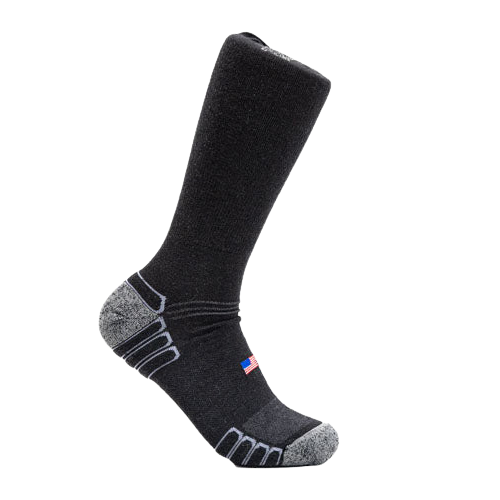The heel on a logger boot isn’t just for show.
It’s got several great functions, and anyone from a logger to a linesman, farm worker to a firefighter, can quickly spot their benefits.
I’ve always liked the look of logger boots, but until I looked deeper into why they have heels, I assumed it was just a throwback to riding boots. Cowboy boots have heels, and for a specific reason, the heel prevents your foot slipping from a stirrup; loggers don’t ride horses up trees though, so I wanted to find out exactly why a logger boot has a heel.
It turns out there are several important reasons why a logger boot has a heel, in fact, it’s why logger boots are so popular with those who work as loggers and linesmen; so today, I’m going to share with you just how vital a logger boot heel is and why you need to know.
Why Are the Heels So High on Logger Boots?

I think it’s important to understand what environments logger boots are used in; the ground they’re designed for is uneven, cluttered, and can often be muddy and dangerous. Loggers will cut down trees, strip branches, deal with boulders and all kinds of terrain, so it’s important to wear the right footwear from the start.
If you’ve ever tried walking up a steep incline when the ground is littered with branches or rocks, you’ll know that pretty soon, your feet feel like they’ve been beaten.
Your muscles will ache too, tensing up as you try to keep traction is exhausting, like wearing dress shoes to ice skate.

A high heel on a logger boot can make all the difference; I’ve found that the raised heel helps keep a better posture because the back of your foot is slightly higher than the front. Scrambling up a slope, the heel gives you better traction and acts as a kind of brake to stop you from slipping.
The heel of a logger boot will sink into damp ground, which helps you to push on when moving uphill, especially if carrying heavy equipment. Both pushing and pulling becomes easier, and you’re less likely to go over on an ankle thanks to the greater grip and ankle support.
Benefits of a Raised Heel
You may be surprised at the number of benefits a heel has; it’s never been about making you taller, although if that’s a bonus to you wearing them, then all the better. No, a heel is a much more useful addition than you might think, and when working outdoors, it can be a big help.
#1 Ankle Support

One of the worst dangers of working on challenging terrain is falling and breaking a bone, especially an ankle. There are times when you could be working alone and far enough away that help isn’t to hand, so the benefit of a raised heel giving your ankle more support is huge. The raised heel on a logger boot helps with your stability and stance by lifting heavy objects like logs or rocks.
Many logger boots are equipped with a steel shank, which makes it much harder to sprain your ankle. If you’ve ever stepped off a curb and mis-stepped, you may have felt your foot go one way, and your ankle another. A steel shank makes a logger boot more rigid, which protects you to the very top of the boot.
Wearing quality boot socks with padding in the right places (like these from Camel City Mill) also helps a lot with ankle support.
#2 Traction Control---the Old Fashioned Way
Clearing a slope of trees or debris, the last thing you want is to start slipping downhill; it’s time to dig those heels in for better traction. In much the same way a hiker will use a walking stick to additional grip by planting the end into softer ground, a heel can make all the difference when you feel your balance going. Digging your heel in prevents you sliding back down the hill.

A logger boot heel can act like a brake; everyone at some point plants a foot down only to end up on their back. That’s fine in the supermarket, but it can be a nightmare out in the woods. It also slows you down and can make even harder work of your day, anything that allows you to get from point A to point B as easily as possible is great. The additional strain on your leg muscles that comes from scrambling around on slippy ground isn’t worth the hassle.
If you’re actually a logger by trade, you can use the heel of your boot when climbing, and a slippy branch won’t feel as dangerous with a heel planted firmly on one side of it. Rolling logs or boulders is easier too; push off whatever it is you’re moving with the heel of your boots. There’s a reason logger boots became so in demand during the late 19th to early 20th century; they make life easier.
#3 Multi-Purpose Boots
Whether you’re a logger or not, the benefits of wearing a logger boot while working outdoors are clear. If you work on a farm or ranch, logger boots can be a great choice of footwear. They offer great foot protection; the grip is excellent, and with a heel, they can even be used when riding.

Farm work can be muddy, back-breaking work, and the last thing you need is to be stuck in the mud. A logger boot helps break the suction of marshy ground due to the profile of the heel; a flat pair of boots means more surface area stuck in the mud, which is harder to pull out. It’s simple yet effective benefits like this that make logger boots so popular with outdoor workers.
The rugged, protective logger boot also appeals to bikers. The heel and superior grip are perfect for changing gears on a bike. Wet weather riding is a breeze, your foot shouldn’t slip from the brakes, and the whole look of a logger boot goes quite well with leather bikers clothing.
#4 Logger Boots Look Good
Okay, so maybe you shouldn’t buy your work boots based on fashion, but there’s nothing wrong with looking good while putting in a shift at work. Logger boots come in various styles and are made from multiple materials, so why not find a pair that suits your look as well as your profession?

A classic-looking leather Georgia Boot Men’s Waterproof Logger Boot is an option at a great price. With a thick sole, high heel, and a Goretex lining to keep your feet dry, these thick leather logger boots offer all the protection you need for those tough jobs. The Georgia boot ties up to the toe, and with solid stud hooks that are attached to steel washers, is as secure as it comes.
Negatives of a Logger Boot
One potential downfall to wearing logger boots is that they excel in harsher conditions, but can be overkill if you’re not dealing with uneven terrain. You could wear logger boots in a warehouse environment, but I wouldn’t advise it. There are many other styles of work boot that suit these types of environment better, although the heel on a logger does act as a shock absorber.
Conclusion
Loggers and outdoor workers have known for over a century; logger boots are the perfect footwear for the kinds of jobs that need that added protection and comfort. It’s also no surprise that this Swiss Army Knife of the boot world is used in so many other industries; if it works, it works.






